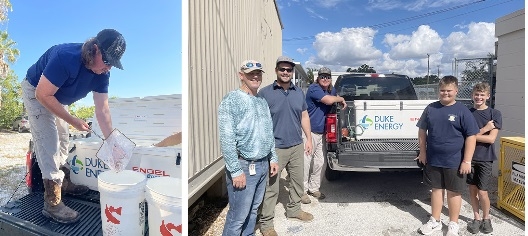Aquaculture in the Classroom program
FWC photos: (left) Mariculture Center staff member putting fingerlings in buckets for transport, and (right) staff members and students.
A collaboration between FWC, Duke Energy's Crystal River Mariculture Center and Coastal Conservation Association
For longer than two decades, the Florida Fish and Wildlife Conservation Commission’s (FWC) Marine Stock Enhancement Research team has been working with school administrators, teachers and students to bring Aquaculture and Stock Enhancement Research into the classroom. The Aquaculture in the Classroom program is designed for students ranging from fifth grade through college. The program teaches students the basic principles of aquaculture, marine research and how stock enhancement plays a role in supporting Florida’s marine fisheries.
Over the past two years, the FWC has teamed up with Duke Energy’s Crystal River Mariculture Center and the Coastal Conservation Association Florida (CCA), which generously provided hatchery-reared red drum (Sciaenops ocellatus) fingerlings to several participating schools along with the Energy and Marine Center in Pasco County.
Through this innovative collaboration, hatchery-reared red drum fingerlings, starter feed and technical advice on how to raise fingerlings in the classroom are provided to schools participating in the Aquaculture in the Classroom program. Information on system development and grant opportunities are also provided. FWC biologists work with teachers to develop curriculum that meets Florida Sunshine State Standards and provides students the opportunity to design aquaculture (fish-raising) systems, perform daily animal husbandry (care) routines and conduct research projects, such as salinity tolerance tests, feed studies and water quality/chemistry investigations.
Since this program began in 2001, more than 30 Florida schools have successfully reared red drum in the classroom. This past year, nine schools participated statewide and 625 red drum fingerlings were distributed.
To learn more about the program, or to refer a teacher or school, email Gina.Russo@MyFWC.com.
The Duke Energy Mariculture Center in Crystal River is a multispecies hatchery that has cultivated and released nearly 5 million fish and crustaceans since 1991. The center is designed to help protect and responsibly manage natural resources, and contribute to the vitality of local communities. Each year, the center raises up to 100,000 redfish and spotted seatrout, and releases them into the Gulf of Mexico to support year-round fishing.
Coastal Conservation Association Florida is a nonprofit organization dedicated to the conservation of Florida’s marine resources. The purpose of CCA is to advise and educate the public on conservation of marine resources. Its objective is to conserve, promote and enhance the present and future availability of those coastal resources for the benefit and enjoyment of the general public.
Partners from CCA and Duke Energy Florida work together to deliver hatchery-reared red drum fingerlings to the Energy and Marine Center in Port Richey, Florida.
CCA in partnership with Duke Energy Florida delivered 150 red drum fingerlings to Stambaugh Middle School in Auburndale, Florida.
Top
A collaboration between FWC, Duke Energy's Crystal River Mariculture Center and Coastal Conservation Association
Florida Fish and Wildlife Conservation Commission (FWC)
For longer than two decades, the Florida Fish and Wildlife Conservation Commission’s (FWC) Marine Stock Enhancement Research team has been working with school administrators, teachers and students to bring Aquaculture and Stock Enhancement Research into the classroom. The Aquaculture in the Classroom program is designed for students ranging from fifth grade through college. The program teaches students the basic principles of aquaculture, marine research and how stock enhancement plays a role in supporting Florida’s marine fisheries.
Over the past two years, the FWC has teamed up with Duke Energy’s Crystal River Mariculture Center and the Coastal Conservation Association Florida (CCA), which generously provided hatchery-reared red drum (Sciaenops ocellatus) fingerlings to several participating schools along with the Energy and Marine Center in Pasco County.
Through this innovative collaboration, hatchery-reared red drum fingerlings, starter feed and technical advice on how to raise fingerlings in the classroom are provided to schools participating in the Aquaculture in the Classroom program. Information on system development and grant opportunities are also provided. FWC biologists work with teachers to develop curriculum that meets Florida Sunshine State Standards and provides students the opportunity to design aquaculture (fish-raising) systems, perform daily animal husbandry (care) routines and conduct research projects, such as salinity tolerance tests, feed studies and water quality/chemistry investigations.
Since this program began in 2001, more than 30 Florida schools have successfully reared red drum in the classroom. This past year, nine schools participated statewide and 625 red drum fingerlings were distributed.
To learn more about the program, or to refer a teacher or school, email Gina.Russo@MyFWC.com.
The Duke Energy Mariculture Center in Crystal River is a multispecies hatchery that has cultivated and released nearly 5 million fish and crustaceans since 1991. The center is designed to help protect and responsibly manage natural resources, and contribute to the vitality of local communities. Each year, the center raises up to 100,000 redfish and spotted seatrout, and releases them into the Gulf of Mexico to support year-round fishing.
Coastal Conservation Association Florida is a nonprofit organization dedicated to the conservation of Florida’s marine resources. The purpose of CCA is to advise and educate the public on conservation of marine resources. Its objective is to conserve, promote and enhance the present and future availability of those coastal resources for the benefit and enjoyment of the general public.
Partners from CCA and Duke Energy Florida work together to deliver hatchery-reared red drum fingerlings to the Energy and Marine Center in Port Richey, Florida.
CCA in partnership with Duke Energy Florida delivered 150 red drum fingerlings to Stambaugh Middle School in Auburndale, Florida.
